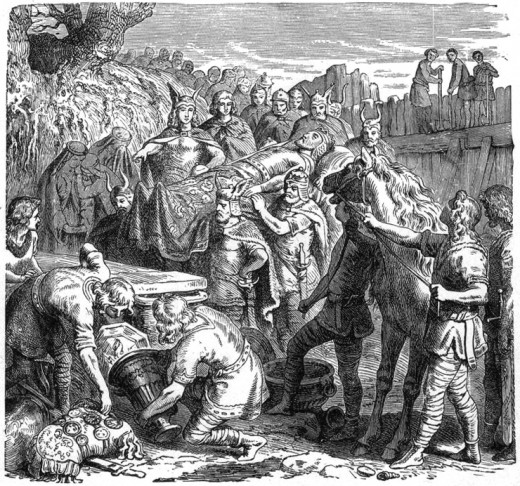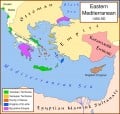Alaric I and the Sack of Rome

Alaric I was born in 370 AD during the migration of the Visigoths from the north across the Danube river. He was born to the influential family of Balti which at the time of his birth were next to royalty. His people had been searching for a place to settle in general and along the way got caught up in Roman politics. During this period the Roman empire employed armies of barbarians and a high number of goths to fight for the empire. Much of the goth population fighting for the empire was allowed to settle, at least temporarily in the empire. The true motive behind this was to lessen the ranks of those that could possibly turn on the Romans and to conserve their own countrymen.
While the Roman empire was still whole Emperor Theodosius I defended his claim to the empire against the usurper known as Eugenius at the battle of Frigidus in 394. During the battle a large Gothic army fought alongside the emperor under the command of Alaric I. During this battle it was the goths that took heavy casualties of approximately 10,000 lives. Although the battle was victorious primarily due to the Gothic forces the emperor paid little attention to their losses and instead praised Rome and himself for the victory. Alaric I received no recognition.
Upon Theodosius death in 395 he split the empire between his two sons Honorius and Arcadius. As Honorius was not yet an adult the high military commander for the the Roman army, Stilicho was appointed as his guardian. Stilicho was a great warrior and was known throughout his life for winning battle after battle. Not long after the empire was split in two the goths revolted against their Roman masters and declared Alaric I king of the Visigoths. Alaric lead his large army of Goths against cities throughout Greece. Stilicho lead his army to attack Alaric I but as he neared the goths with the great might of Rome, and most likely would have defeated Alaric I, he was ordered out of Greece by Arcadius.
With nothing to stop him Alaric I sacked several key cities in Greece and captured many of the people which were sold into slavery. Again Stilicho crossed the sea from Italy to Greece and cornered the Goths in a mountain pass, again with enough might to destroy them but again was ordered out of Greece. Alaric I continued sacking cities until the eastern empire gave him the title of high commander of all armies in Greece.
In the year 401 AD Alaric attempted to invade Italy but was defeated by Stilicho at Pollentia in northern Italy and again Stilicho defeated him in Verona in 403 AD. At some point by 407 Stilicho and Alaric I had allied their forces and Stilicho was going to have Alaric I take part or all of the Eastern roman empire for the west. However with the death of Arcadius they seemed to stop their plan.
For some unknown reason at this point Honorius, possibly on the deceitful consul of some of Stilicho's enemies, had Stilicho executed. After this he ordered the deaths of gothic slaves in Italy. These mistakes only served to drive massive numbers of Gothic slaves to joins Alaric's army and assist in his march on Rome, now without a great commander like Stilicho to defend it. Poised to take Rome Alaric I demanded tribute as well as land to settle his people and the title of commander-in-chief of all Roman armies. After Honorius would not grant him the title they attempted to set up another Emperor to claim the empire. This had little effect and the Goths were eventually forced to march on Rome.
Eventually as the Roman population was starving from the Visigoths blocade of the city and someone from within the city opened the gates. Alaric I and his army laid siege to the city for three days. Although during this time very little was actually damaged in the city it was clear that this was the beginning of the end for the Roman empire. this had been the first time in 800 years that a foreign army had breached the walls of Rome.
After Rome was taken Alaric I headed south and was going to cross the mediterranean sea and enter Africa however his ships were destroyed by a storm. Shortly after this in 310 AD Alaric died in Cosenza of some unknown fever and was buried beneath the riverbed of the Busento. It is said the river was diverted to dig his grave and then allowed to flow back in it's original direction. Those who did the work and committed his body to the ground were killed immediately afterward so that none would know the exact site of his burial.
Eventually in years to come the Visigoths would eventually settle and make their kingdom in Spain and southern France.








